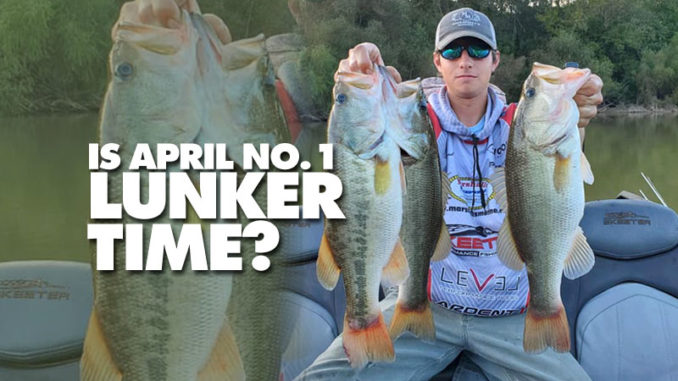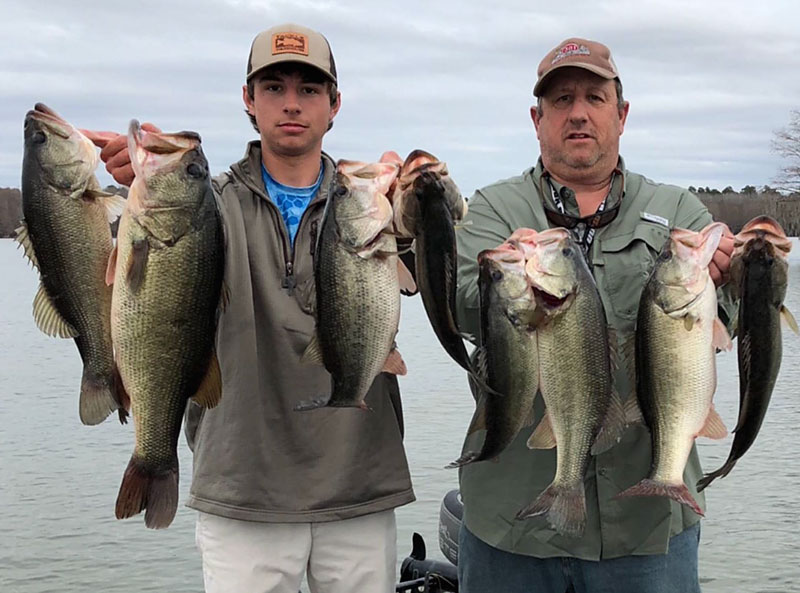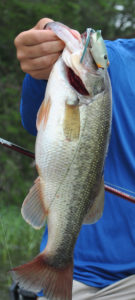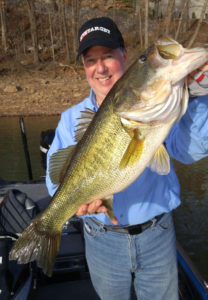
Bass pro said waves of fish will be coming and going all month, giving fishermen opportunities for great trips.
April in the Carolinas provides bass fishermen with more than one opportunity to catch some big lunkers.
While March gets a lot of fanfare as the top month for big fish, plenty of fish are spawning in April as well. It’s one of Cole Drummond’s favorite times to go after bass.
“The weather is usually more stable in April than it was in March, so that always helps. And no matter how active bass were in March, you’re still going to have plenty of fish in pre-spawn and post-spawn this month,” said Drummond, a pro bass fisherman from Florence, S.C.
He finds prespawn bass at staging points as they wait to head in to spawn. Brush piles between the main lake and the flats in 7 to 9 feet of water are key areas. He’ll fish around those with crankbaits, jigs and weighted soft plastics.
“If I’m using a crankbait, I usually like it to dig into the bottom to draw those reaction strikes. It’s also good for bouncing off of the brush piles and other debris,” he said.
What Drummond really likes to see when April arrives are bass spawning in the shallows and guarding fry after spawning.
Male bass arrive in shallows before females, which are close by
“Bass spawn in waves,” he said. “By April, one or two waves of fish will have already spawned and moved out, but others are moving in, spawning, then moving out. You’ll see them in all stages of the spawn this month.”

Drummond said the smaller, male bass build nests in shallow water before the females arrive — and they aren’t far behind.
“They might be 40 feet away in slightly deeper water, or they might be 40 yards away, but they’ll be close, and they’ll be heading shallow very soon,” he said. “You’ll know the males because they’re just smaller fish. If you’re (fishing down) a shoreline and catching lots of fish, but none of them are 4-pounders, that’s all males building nests. When that happens, you can just ease out to slightly deeper water and start finding the bigger females,” he said.
The moon phase plays a big part in the behavior of bass this month, Drummond said; he always wants to be on the water from four days before the full moon to four days after it.

“They’re really active during that time period. They’ll get real shallow — more shallow than most anglers are willing to fish,” he said. “And if you’ll put in the time and trouble to get to them, you will just catch them, plain and simple.”
The shallower, the better
When Drummond says shallow, he definitely means shallow. When he heads onto a shallow flat off the main lake, and he starts bumping the bottom with his trolling motor, then sees a line of lily pads or other surface vegetation with shallower water behind it, that’s where he wants to go more than anywhere else this time of year.
“Most people don’t like it because it’s hard to get in there and takes a lot of time. It can be hard on equipment, too, and there’s no avoiding making a lot of noise,” he said. “This is literally inches of water. But once you get in there, just wait a little while and things will settle down. The bass in here will come back to their nests or their fry once it quiets back down.”
Once that happens, Drummond said a topwater frog is irresistible to the fish.
“A hollow-body popping frog is good, and the Stanley Ribbit frog is another good one,” he said. “It’s not hollow, but it rides on top and the legs drag and kick in the water. The fish get really mad when you reel that through, and they will just kill it. And you don’t have to work the frog with any kind of action. Just straight reeling is all it takes.”
Staging areas become active again
Once the females spawn and are done guarding their fry, they’ll head to those same spots they staged on before spawning.
“They’ll go back to those staging areas, like brush piles in 7 to 9 feet of water,” he said. “They’ll be pretty worn out now — and hungry. The fish won’t be as big since they’ve already spawned out, but they’ll bite a little more aggressively, a little more predictably. And even very late, down to the last days of this month, you’ll still catch some in prespawn mode. Those waves of bass are coming in, spawning, then moving out throughout the spring. So you’ll catch some that have already spawned and others that are still in prespawn in the same spots.”
Fill up the beds
When fishing for bedding bass, it’s not uncommon for fish to ignore your lures, or to grab them, move them out of their bed, then spit them out.

It can make for a frustrating day.
Veteran angler Gary Abernethy of Asheville, N.C., has a solution for that. He simply sets his rod down, allowing the lure to stay put.
“When you have fish doing that, it’s just a matter of time before they get tired of messing with your lures. At some point, they’ll eat one just to get rid of it, even if the fish isn’t hungry,” he said.
This is especially effective when the water is shallow and clear enough to see the fish.
Be ready for the bite
“Cast a creature bait in there, and they’ll sometimes act like they don’t even see it. But they see it. Let in lay in the middle of its bed, set your rod down, and pick up another rod. Work a jig into the bed. If the fish ignores it, do the same thing. Pick up another rod. Even if it grabs it and spits it out on the edge of the bed, just let it stay put. Cast another lure in there. If the fish doesn’t eat it, let it lay, too,” he said.
Abernethy said the bass will start getting nervous as its bed fills up with other creatures that could eat its eggs or fry. It helps to have a good shallow-water anchoring system here to keep your boat steady so your lures stay in the fish’s bed.
“Every fish has its own tipping point. You put three or four lures in its bed, and it’ll get tired of dealing with them at some point. Just be ready, because when that fish decides to eat, it’s going to happen real quick,” he said.




Be the first to comment